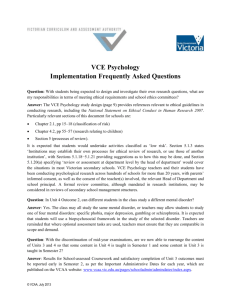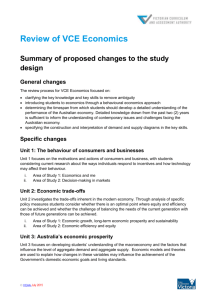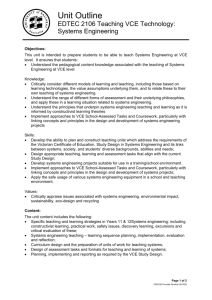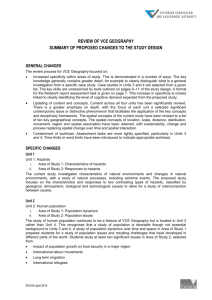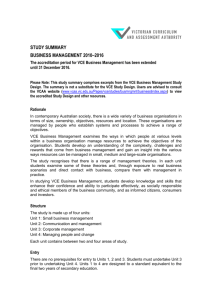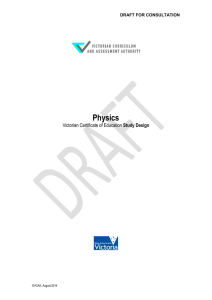Review of VCE Physical education
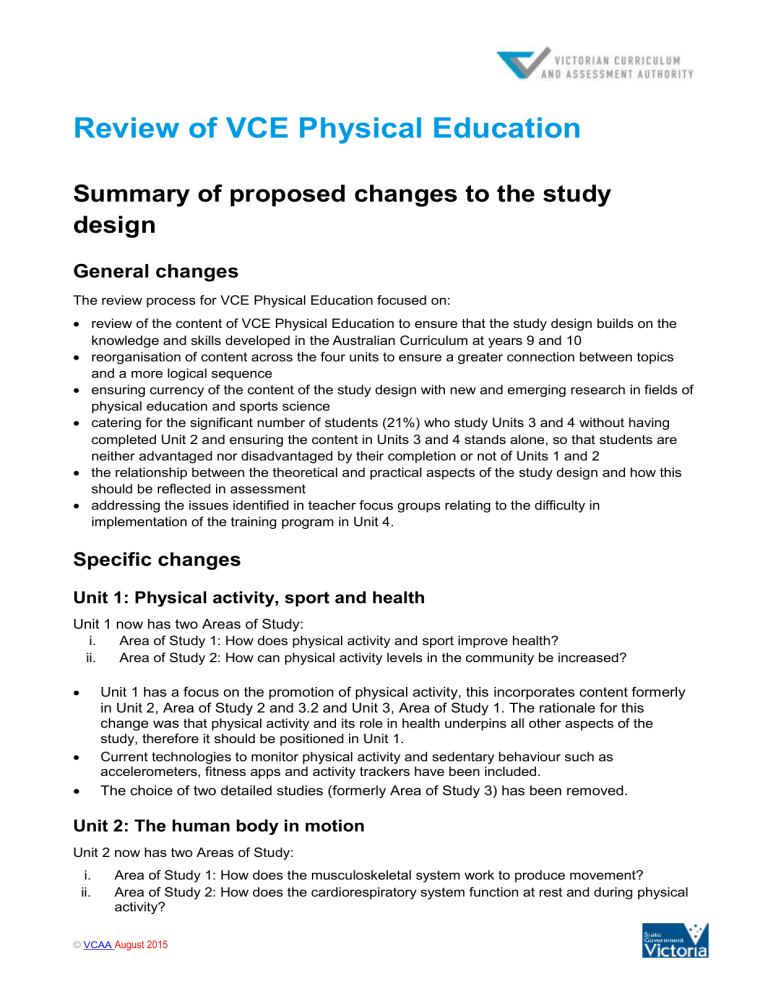
Review of VCE Physical Education
Summary of proposed changes to the study design
General changes
The review process for VCE Physical Education focused on:
review of the content of VCE Physical Education to ensure that the study design builds on the knowledge and skills developed in the Australian Curriculum at years 9 and 10
reorganisation of content across the four units to ensure a greater connection between topics and a more logical sequence
ensuring currency of the content of the study design with new and emerging research in fields of physical education and sports science
catering for the significant number of students (21%) who study Units 3 and 4 without having completed Unit 2 and ensuring the content in Units 3 and 4 stands alone, so that students are neither advantaged nor disadvantaged by their completion or not of Units 1 and 2
the relationship between the theoretical and practical aspects of the study design and how this should be reflected in assessment
addressing the issues identified in teacher focus groups relating to the difficulty in implementation of the training program in Unit 4.
Specific changes
Unit 1: Physical activity, sport and health
Unit 1 now has two Areas of Study:
i. Area of Study 1: How does physical activity and sport improve health? ii. Area of Study 2: How can physical activity levels in the community be increased?
Unit 1 has a focus on the promotion of physical activity, this incorporates content formerly in Unit 2, Area of Study 2 and 3.2 and Unit 3, Area of Study 1. The rationale for this change was
that physical activity and its role in health underpins all other aspects of the study, therefore it should be positioned in Unit 1.
Current technologies to monitor physical activity and sedentary behaviour such as accelerometers, fitness apps and activity trackers have been included.
The choice of two detailed studies (formerly Area of Study 3) has been removed.
Unit 2: The human body in motion
Unit 2 now has two Areas of Study: i. Area of Study 1: How does the musculoskeletal system work to produce movement? ii. Area of Study 2: How does the cardiorespiratory system function at rest and during physical activity?
© VCAA
August 2015
Review of VCE Physical Education
Unit two contains content formerly in Unit 1 and Unit 4.
Overlap with Unit 3 energy systems has been removed.
The choice of two detailed studies (formerly Area of Study 3) has been removed.
Unit 3: Analysis of movement and energy production
Unit 3 retains two Areas of Study: i. Area of Study 1: How are movement skills analysed and improved? ii. Area of Study 2: How does the body produce energy?
Area of Study 1 contains Unit 1 and 2 content from the current study design and has been updated to ensure it reflects contemporary approaches to skill acquisition.
The use of available technologies to analyse movement skills from a biomechanical perspective has been included.
Area of Study 2 maintains a focus on the physiological requirements for physical activity and contains very few changes.
Unit 4: Training to improve performance
Unit 4 retains two Areas of Study: i. Area of Study 1: What are the foundations of an effective training program? ii. Area of Study 2: How is training effectively implemented to improve performance from a physiological perspective?
The emphasis on training to improve performance has been strengthened.
Contemporary training methods such as high intensity interval training and the use of technology in training programs have been included.
The content of the current Area of Study 2 has been either moved or deleted to allow more time to implement and evaluate training sessions. This includes:
nutritional and physiological strategies to enhance recovery moved to Unit 3
psychological strategies to enhance performance and aid recovery is no longer included in the study design
perceived benefits and potential harms of legal and illegal substances and methods of enhancing performance has been moved to Unit 2.
© VCAA
August 2015
Page 2
Review of VCE Physical Education
Assessment
Outcome statements in all areas of study across Units 1 to 4 have been altered to reflect the focus of the unit.
Units 1 and 2 proposed outcome statements and assessment
Consultation Draft Outcome Statements
Unit 1
Area of Study 1
Collect and analyse data related to individual levels of participation in physical activity to create, undertake and evaluate an activity plan that meets the physical activity and sedentary behaviour guidelines for their age group.
Proposed Assessment
The assessment task for Outcome 1 is:
a written physical activity plan and a reflective folio demonstrating participation in the physical activity plan designed to meet the physical activity and sedentary behaviour guidelines.
Area of Study 2
Analyse population levels of sedentary behaviour and participation in physical activity, and evaluate settings based initiatives and strategies that enable individuals and communities to implement the physical activity and sedentary behaviour guidelines to improve health and well-being.
Suitable tasks for assessment of Outcome 2 may be selected from the following:
a practical laboratory report linking key knowledge and key skills to practical activity
a case study analysis
a data analysis
a critically reflective folio/diary of participation in practical activities
a visual presentation such as a graphic organiser, concept/mind map, annotated poster, presentation file
a multimedia presentation, including two or more data types (for example, text, still and moving images, sound) and involving some form of interaction
a physical simulation or model
an oral presentation such as podcast, debate
a written report.
© VCAA
August 2015
Page 3
Review of VCE Physical Education
Unit 2
Area of Study 1
Collect and analyse information from, and participate in, a variety of practical activities to explain how the musculoskeletal system functions, its limiting conditions and evaluate legal and illegal practices and substances that enhance human movement.
Area of Study 2
Collect and analyse information from, and participate in, a variety of practical activities to explain how the cardiovascular and respiratory systems function, limiting conditions of each system and how legal and illegal practices and substances enhance the performance of these two systems.
The compulsory assessment task for Outcomes 1 and 2 is:
a written report analysing participation in at least four physical activities that demonstrate how the musculoskeletal and cardiorespiratory systems work together to produce movement.
Additionally, at least one task for the assessment of
Outcomes 1 and 2 is to be selected from the following:
a practical laboratory report linking key knowledge and key skills to practical activity
a case study analysis
a data analysis
a critically reflective folio/diary of participation in practical activities
a visual presentation such as a graphic organiser, concept/mind map, annotated poster, presentation file
a multimedia presentation, including two or more data types (for example, text, still and moving images, sound) and involving some form of interaction
a physical simulation or model
an oral presentation such as podcast, debate
a written report
a test.
Unit 3 Proposed outcome statements and assessment
Outcomes
Outcome 1
Collect and analyse information from, and participate in, a variety of practical activities to develop and refine movement skills through the application of biomechanical and skill acquisition principles.
Marks Allocated
50
Assessment Tasks
Structured questions that draw on primary data which analyses a movement skill using biomechanical and skill acquisition principles.
Outcome 2
Use data collected in practical activities to analyse how the major body and energy systems work together to enable movements to occur, explain the fatigue mechanisms and evaluate suitable recovery strategies.
25
A laboratory report based on primary data collected during participation in a practical activity that analyses the relative contribution of energy systems and acute responses to exercise.
25
A response in one or more of the following forms, which focus on fatigue and recovery.
a practical laboratory report
a case study analysis
a data analysis
a critically reflective folio/diary of participation in practical activities
a visual presentation
a multimedia presentation
a test.
Total Marks 100
*School-assessed Coursework for Unit 3 contributes 25 per cent to the study score.
© VCAA
August 2015
Page 4
Review of VCE Physical Education
Unit 4 Proposed outcome statements and assessment
Outcomes
Outcome 1
Conduct an activity analysis and fitness tests to determine and assess the fitness components and energy system requirements of a selected sport.
Outcome 2
Participate in a variety of training methods, design and evaluate training programs to enhance specific fitness components.
Marks Allocated Assessment Tasks
30
A written report analysing data from an activity analysis to determine the relevant fitness components and energy system requirements in a selected activity and justification of the selection of appropriate tests to assess fitness.
50
A critically reflective folio of participation in a minimum of five different training sessions focusing on the components of the session, the training method completed and the implementation of training principles to the fitness components being trained. Students will draw on the personal experiences recorded in the folio to design a sixweek training program for a given case study.
20
A response in one or more of the following formats, which links chronic adaptations of the cardiovascular, respiratory and muscular systems to training methods and improved performance:
a case study analysis
a data analysis a test.
Total Marks 100
*School-assessed Coursework for Unit 4 contributes 25 per cent to the study score.
© VCAA
August 2015
Page 5

